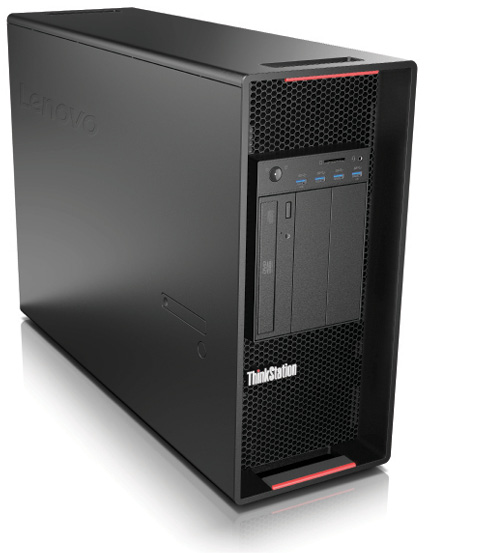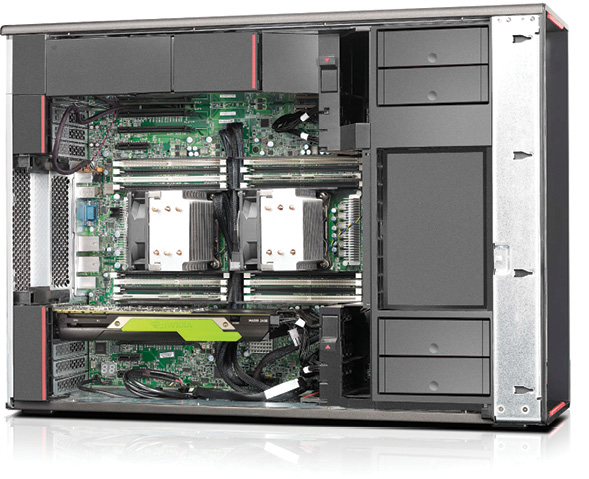Big & Powerful: Lenovo ThinkStation P910 Signature Edition Review

The new Lenovo ThinkStation P910 is an update of the company’s flagship workstation, designed to meet the needs of the most demanding users. Image courtesy of Lenovo.
Latest News
October 1, 2017
Lenovo recently sent us the latest iteration of its flagship workstation, the ThinkStation 910 Signature Edition. This is actually a refresh of the P910, designed to support the latest Intel Xeon E5-2600 v4 series CPU in dual processor configurations with the latest NVIDIA graphics cards, up to 896GB of memory and drives with higher storage capacities.
We reviewed the original ThinkStation P900 (DE, August 2015), nearly a year after it was first unveiled at SIGGRAPH 2014. That workstation represented a total redesign of the P-series and featured a new, tool-less case. The updated ThinkStation P910 comes housed in the same large tower case that measures 7.8x17.6x24.4-in. (WxHxD) and weighs 51.25 pounds. Despite its weight, three large handles make it easy to move the system. Those handles are each marked with red touch points—a feature that also appears inside the case.
The front panel includes a FLEX module that gives users the option of adding just the components they need. It can accommodate optical drives, a 29-in-1 card reader, and iEEE 1394 FireWire and eSATA ports. In our evaluation unit, the FLEX module contained the power button, a 9-in-1 media card reader, a headphone/microphone combo jack, and four USB 3.0 ports, including one that is always on and capable of charging USB devices and a second that can be used for diagnostics. Below this are three vertical 5.25-in. drive bays, one of which contained a standard 5.25-in. DVD+/-RW dual-layer optical drive.
 The new Lenovo ThinkStation P910 is an update of the company’s flagship workstation, designed to meet the needs of the most demanding users. Image courtesy of Lenovo.
The new Lenovo ThinkStation P910 is an update of the company’s flagship workstation, designed to meet the needs of the most demanding users. Image courtesy of Lenovo.The rear panel provides PS/2 keyboard and mouse ports, a nine-pin serial port, four more USB 3.0 ports, four USB 2.0 ports, two RJ45 network jacks and audio jacks for line-in, line-out and microphone. The NVIDIA GPU in our evaluation unit added its own DVI port and four DisplayPorts.
Lots of Options
To access the interior of the P910, you simply lift a lever that releases the entire left side panel. Inside, those aforementioned red touch points provide clear indications of where to grasp components that require absolutely no tools to remove. For example, the 1,300-watt power supply, with its own built-in self-test, can be swapped out in seconds by pulling on its red touch point. Even the motherboard can be removed without tools after taking out all of the other components.
A large direct cooling air baffle occupies the center of the case. This baffle conceals the two CPUs and memory sockets. Three channels ensure that each CPU and the memory sockets receive their own direct airflow.
 An air baffle conceals the CPU and memory sockets and ensures that fresh air reaches these crucial components. Image courtesy of Lenovo.
An air baffle conceals the CPU and memory sockets and ensures that fresh air reaches these crucial components. Image courtesy of Lenovo.The $1,899 base configuration comes with a single Intel Xeon E5-2609 v4 processor (an eight-core, 1.7GHz CPU), 8GB of 2400MHz ECC memory, an NVIDIA NVS315 graphics board and a 1TB 7200rpm SATA hard drive. Lenovo offers a choice of eight different Intel Xeon CPUs ranging from four to 12 cores and speeds up to 3.5GHz. And with its two sockets, you can opt for one or two CPUs. Our evaluation unit came with a pair of Intel Xeon E5-2620 v4 processors, which added $820 to the base price. Those eight-core Broadwell CPUs run at a rather sedate 2.1GHz, with a maximum turbo speed of 3.0GHz, provide 20MB SmartCache each and have an 85-watt thermal design power rating.
The base P910 configuration comes with 8GB of RAM, installed as a single 8GB 2400MHz ECC RDIMM module. The review system came with 32GB of memory (adding $342). Filling all 16 sockets with 32GB RDIMM modules would provide 512GB of memory and boost the cost by $7,236.
The motherboard provides a total of eight PCIe expansion slots, arranged in groups on either side of the CPUs and memory sockets. The upper group consists of a pair of Gen3 x16 graphics card slots and a single Gen2.0 x4 slot. The lower group provides a second pair of x16 graphics card slots, another x4 slot, and a pair of x1 card slots. The base P910 configuration comes with an NVIDIA NVS315 DMS-59 graphics card, an entry-level board with 1GB of dedicated memory and a pair of DisplayPorts. The system we received included an NVIDIA Quadro P6000. This top-of-the-line graphics card incorporates 3840 CUDA cores and 24GB of GDDR5X memory. The 250-watt power demands of this VR-ready board require an auxiliary eight-pin connector and it covers the adjacent expansion slot.
| Workstation Performance Compared | Lenovo ThinkStation P910 Signature Edition (two 2.1GHz Intel Xeon E5-2867V4 8-core CPUs, NVIDIA Quadro P6000, 32GB RAM, 1TB PCIe M.2 SSD) | Lenovo ThinkStation P410 (one 3.6GHz Intel Xeon E5-1650 v4 6-core CPU, NVIDIA Quadro M4000, 16GB RAM, 1TB SATA SSD HD) | BOXX APEXX 2 2402 (one 4.0GHz Intel Core i7-6700K 4-core CPU over-clocked to 4.4GHz, NVIDIA Quadro M5000, 16GB RAM, 800GB PCIe SSD) | Lenovo ThinkPad P70 17.3-inch mobile workstation (2.8GHz Intel Xeon E3-1505M v5 quad-core CPU, NVIDIA Quadro M4000M, 16GB RAM, 500GB PCIe SSD) |
| Price as tested | $8,080 | $2,515 | $5,806 | $3,623 |
| Date tested | 5/18/17 | 10/26/16 | 1/30/16 | 2/12/16 |
| Operating System | Windows 10 | Windows 10 | Windows 10 | Windows 7 |
| SPECviewperf 12 (higher is better) | ||||
| catia-04 | 154.86 | 89.66 | 133.05 | 80.54 |
| creo-01 | 110.01 | 76.93 | 108.03 | 66.69 |
| energy-01 | 31.83 | 6.34 | 11.44 | 6.39 |
| maya-04 | 95.06 | 63.31 | 101.53 | 54.93 |
| medical-01 | 113.27 | 26.62 | 45.12 | 27.23 |
| showcase-01 | 131.80 | 46.58 | 60.37 | 46.70 |
| snx-02 | 400.78 | 125.39 | 121.01 | 112.86 |
| sw-03 | 156.25 | 106.37 | 158.22 | 88.04 |
| SPECapc SOLIDWORKS 2015 (higher is better) | ||||
| Graphics Composite | 4.17 | 8.08 | 7.65 | 4.62 |
| Shaded Graphics Sub-Composite | 2.79 | 4.87 | 4.19 | 2.41 |
| Shaded w/Edges Graphics Sub-Composite | 3.36 | 5.97 | 5.57 | 3.42 |
| Shaded using RealView Sub-Composite | 3.15 | 6.43 | 5.45 | 3.41 |
| Shaded w/Edges using RealView Sub-Composite | 3.65 | 9.99 | 9.01 | 5.89 |
| Shaded using RealView and Shadows Sub-Composite | 3.59 | 7.23 | 6.77 | 3.87 |
| Shaded with Edges using RealView and Shadows Graphics Sub-Composite | 3.81 | 10.47 | 10.29 | 6.19 |
| Shaded using RealView and Shadows and Ambient Occlusion Graphics Sub-Composite | 11.52 | 16.01 | 14.87 | 7.97 |
| Shaded with Edges using RealView and Shadows and Ambient Occlusion Graphics Sub-Composite | 10.93 | 22.75 | 21.17 | 12.01 |
| Wireframe Graphics Sub-Composite | 2.54 | 3.26 | 4.19 | 3.02 |
| CPU Composite | 3.01 | 5.08 | 6.09 | 3.47 |
| SPECwpc v2.0 (higher is better) | ||||
| Media and Entertainment | 4.22 | 2.84 | 3.52 | 2.60 |
| Product Development | 4.33 | 2.79 | 3.06 | 2.32 |
| Life Sciences | 6.32 | 3.03 | 3.65 | 2.56 |
| Financial Services | 7.55 | 4.60 | 1.54 | 1.14 |
| Energy | 6.07 | 3.11 | 3.17 | 2.27 |
| General Operations | 1.43 | 1.14 | 1.99 | 1.41 |
| Time (lower is better) | ||||
| Autodesk Render Test (in seconds) | 54.10 | 50.10 | 41.70 | 50.00 |
Numbers in blue indicate best recorded results. Numbers in red indicate worst recorded results. * Results provided by Lenovo.
Along the front portion of the case are four 5.25-in. drive bays, separated by the FLEX module and again identified by red touch points. Each bay uses blind connectors and a tray design that can accommodate a 3.5-in. or 2.5-in. drive, or a pair of 2.5-in. drives. The base configuration includes a 1TB 7200rpm SATA drive, but Lenovo offers lots of choices, including SSD drives from 256GB to 1TB and mechanical drives of up to 4TB capacities. You can also order systems configured with multiple drives in various RAID arrays. There is also a pair of internal FLEX connectors that can support up to four PCIe drives. Our evaluation unit came with a single 1TB PCIe M.2 drive. All told, the ThinkStation P910 can accommodate up to 40TB of storage.
Mixed Results
With its ultra-high-end NVIDIA GPU, the new Lenovo ThinkStation P910 delivered the fastest results we have ever recorded for all but one dataset in the SPECviewperf benchmark of graphics performance. But with its CPU running at a base frequency of only 2.1GHz, the P910 did not set any records on the SPECapc SolidWorks test, lagging behind many of the other systems we’ve tested recently.
Once we turned our attention to the demanding SPECwpc workstation performance benchmark, however, the ThinkStation P910 again came out on top compared with other recent workstations we reviewed. But on the AutoCAD rendering test, its results were below those of other recent workstations. The sound of the internal fans never varied during any of our tests, but the sound pressure level remained a very noticeable 50dB, even at rest.
Lenovo preloaded Windows 10 Professional 64-bit. Windows 7 is also available. Like other Lenovo workstations, the new ThinkStation 910 comes with a three-year on-site warranty. The system is ISV certified for applications from companies including Adobe, Autodesk, Dassault and PTC.
The starting price of the ThinkStation P910 belies the potential within. Few are likely to purchase a system with this much potential equipped with entry-level components. The system we reviewed is not available from Lenovo. It is available from CDW, at a cost of $8,080. Those looking for a better balance of price and performance for MCAD applications might be better served with a pair of high-end CPUs and a slightly lesser GPU.
This new Lenovo ThinkStation P910 is aimed at high-end CAD, CAE, R&D, rendering, special effects and the oil and gas industries. But if you need an extremely powerful system with lots of expansion capabilities, you need look no further than the Lenovo ThinkStation P910.
More Info
Lenovo ThinkStation P910 Signature Edition
- Price: $8,080 as tested ($1,899 base price)
- Size: 7.87x24.41x17.56-in. (WxHxD) tower
- Weight: 51.25 pounds
- CPU: Two 2.1GHz Intel Xeon eight-core E5-2620 v4
- Memory: 32GB DDR4 ECC at 2400MHz
- Graphics: NVIDIA Quadro P6000
- Hard Disk: 1TB Samsung PCIe M.2
- Optical: 16X DVD+/-RW
- Audio: Integrated Realtek ALC662 audio
- Network: Integrated gigabit Ethernet, one RJ45 port
- Other: Eight USB 3.0 (4 front/4 rear), four USB 2.0 ports rear, one 9-pin serial, PS/2 mouse and keyboard ports, one DVI port and four DisplayPorts on NVIDIA board, 9-in-1 media card reader
- Power supply: 1,300 watts, 92%
- Warranty: Three-year parts and labor
Subscribe to our FREE magazine, FREE email newsletters or both!
Latest News
About the Author
David Cohn is a consultant and technical writer based in Bellingham, WA, and has been benchmarking PCs since 1984. He is a Contributing Editor to Digital Engineering, the former senior content manager at 4D Technologies, and the author of more than a dozen books. Email at [email protected] or visit his website at www.dscohn.com.
Follow DE





